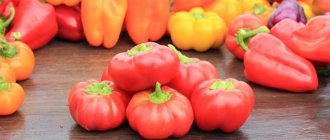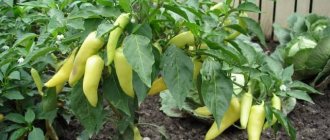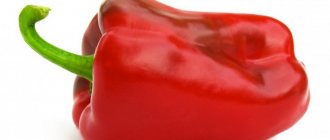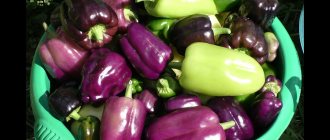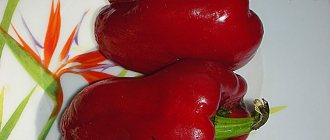Pepper variety Bychok belongs to the sweet peppers. In our country they are persistently called “Bulgarian”. Sweet peppers are loved by many; their use in cooking is very diverse: in vegetable salads, in first and second courses, in winter preparations. Therefore, gardeners always plant sweet peppers on their plots every season.
The variety of varieties and hybrids is amazing. We will talk about the Bychok variety. For lovers of orange peppers this will be a real find.
Description of the variety
Although Bychok pepper is sometimes called Bulgarian, it has taken root well in different regions of Russia. Depending on the climate, it is necessary to wait 3-4 months before the first harvest is harvested.
This variety is classified as a spreading plant, reaching half a meter in height.
The leaves of the plant are green and medium in size. They have a slightly wrinkled surface. Note: the fruits of this pepper variety reach 150 g in weight and, when biologically mature, acquire one of the orange shades.
Pepper of the Bychok variety, when technically ripe, acquires a cone-shaped, rounded shape with a slightly narrowed top and weak ribbing. Inside it there are several chambers with seeds. The fruit wall reaches 5-6 mm and is distinguished by its juiciness, pleasant taste and aroma.
Advantages and disadvantages
Pepper Bychok has become widespread due to a number of undoubted advantages:
- This species belongs to the universal varieties that take root in different climatic zones.
- The variety showed good results in greenhouse conditions and when planted in open ground.
- One of the undoubted advantages of this variety of pepper is its high yield. So, from a plot the size of a square meter you can get about 5 kg of harvest or more.
- During the selection process, the variety was vaccinated against fungal infections and other diseases dangerous to the plant. This makes the work of the summer resident easier.
- The fruits of this type of pepper are distinguished not only by a large amount of vitamins, but also by a pleasant taste. A large number of culinary recipes have been invented using them. This ensures constant high demand for this type of pepper.
When growing this crop, it is worth considering that a lack of light and heat can affect the health of the seedlings and at the same time reduce the yield. Among the main disadvantages, gardeners point out only the high price of seeds.
Resistance to diseases and pests
Having talked about the characteristics and descriptions of the sweet pepper variety “Bychok”, we did not talk about a very important fact - ailments. Diseases can quickly destroy any crop, as can pests. But “Bychok” is a rather strong variety in this regard. Pre-sowing seed treatment, competent agricultural technology and compliance with predecessors are the factors that help avoid the risks of disease.
As for insects, they can harm most mid-season crops. Timely struggle and attention will help solve the problem quickly. You must monitor the condition of the bushes outside and in the greenhouse. Parasites may not be visible visually, as they often settle on the back side of the leaf, in the axils. The summer resident notices that the crop gets sick only when external signs appear - wilting, curling of leaves. In this case, it is necessary to wage a drastic fight with insecticides.
To prevent an attack, carry out preventative measures by planting nearby crops that insects do not like or flowers. This could be onions, garlic, or strong-smelling herbs. Tobacco dust or ash is also scattered around the area and bait is placed in the form of a sweet solution. Folk infusions based on the same herbs, garlic arrows, and spices help drive away colonies of parasites. A solution of potassium permanganate is an excellent disease prevention.
Read also: Strawberry Kupchikha: description of the variety, photos, reviews
Time to prepare seedlings
In order to have time to harvest in the summer, you need to start preparing seedlings at the end of February or beginning of March. To do this, you will need to prepare fertile soil.
Tip: to get good soil and save a little money, you need to take soil from the garden and mix it with store-bought soil and sand in a 1:1:1 ratio.
As soon as the container is filled with soil, seeds are placed into it to a depth of 1-1.5 cm. The distance between future seedlings should be such that their root systems do not interfere with each other.
A prerequisite for obtaining better seed germination is the presence of heat and light. Since natural indicators are insufficient at the beginning of spring, it is necessary to provide the seedlings with all this additionally. So, a container with seedlings can be covered with film, thus creating a greenhouse effect. The second step is to provide artificial lighting, which will extend their natural daylight hours.
After the seeds germinate, you need to wait until the first two true leaves appear on the plants. For an experienced gardener, this is a sign by which the timing of picking plants is determined. After planting in separate containers, watering is necessary. After 2 weeks, you will need to fertilize the ground under the seedlings with one of the liquid compounds that can be purchased in the store.
Landing in the ground
Towards the end of spring there comes a period in which peppers are planted in open ground. From the moment the seeds are planted to the start of this process, 40-60 days pass. In order for the seedlings to take root well in the new soil, there is no need to start this process ahead of schedule. Keeping young peppers indoors for more than 60 days can cause them to become too large. This will make transportation and disembarkation difficult.
Depending on the climatic conditions in a particular area, it is worth deciding whether a greenhouse is necessary. Here it is worth considering the principle: if at night the air temperature drops below +14 degrees, the plants will need shelter.
To ensure good growth, it is necessary to determine the location for the bed and prepare it correctly. The choice will be greatly influenced by the crop that was planted in this area last season. Pepper seedlings will take root well where they previously grew:
- onion;
- cucumbers;
- pumpkin;
- cabbage;
- zucchini:
- carrot.
Please note : you should not plant Bychok peppers in beds that last season were allocated for potatoes, tomatoes, eggplants or nightshades.
It is worth remembering that heavy clay soil is not very suitable for this type of plant. You can improve the conditions on such soil by fertilizing it with peat or humus. Before planting peppers, you need to prepare the holes. They should be 30 cm apart and 50 cm between rows. This will ensure the possibility of full development of the root system for each seedling.
Immediately before placing the plant in the hole, you need to put a spoonful of mineral fertilizer on its bottom, which should then be mixed with the soil. It is important to remove the seedling from the container so as not to damage its root system. Afterwards it is carefully transferred to the hole.
First, you need to cover only half of the hole with earth, and after watering, you need to completely fill the hole. Finally, you need to install pegs and, if necessary, immediately tie up the seedlings.
Rules for growing pepper "Bychok"
Most varieties of sweet peppers in the cool climatic conditions of Russia are typically grown using the seedling method, and the pepper variety “Bychok” was no exception. Experienced agronomists advise you to follow the following algorithm of actions for growing this variety:
- Preparing the soil for seedlings.
- Seed calibration and treatment.
- Planting seeds for seedlings and care until planting in the ground.
- Planting seedlings in open ground and caring for them before harvesting.
Preparing the soil for seedlings
Pepper “Bychok” grows on nutritious, slightly sandy soil, so for seedlings, the following mixture is usually prepared: mix one bucket of humus, peat and river sand. After mixing, the resulting soil should be pickled (disinfected). Depending on the chosen method, the soil begins to be prepared from the beginning of winter until the moment of planting the seedlings. The most time-consuming method is soil freezing, which requires the soil mixture to remain at sub-zero temperatures for at least a month.
Methods of exposure to high temperatures take no more than 40 minutes, but if you expose the soil to temperatures above 100 ºС, there is a risk of loss of nutrients. These methods include treating the soil in a bag in a steam bath, as well as calcining it in the oven.
You can also treat the soil chemically. For example, disinfect with fungicides Agat, Apron, Phoenix, Alpha Doctor and any others intended to combat sweet pepper diseases. The simplest and cheapest option is to treat with a 2% solution of potassium permanganate in warm water. Treatment method: spraying the soil mixture with a solution of fungicide or potassium permanganate.
Preparing seeds for seedlings
First of all, the seed selection process is carried out - calibration. Experienced agronomists offer the following methods. The first one is manual calibration. You need to pour the seeds onto paper and use a match to separate damaged and small seeds. Large ones are also suitable, but medium-sized seeds are considered optimal.
Another method is to prepare a 5% solution of table salt. The seeds are poured into a container with a solution. Those that float up are empty and need to be collected and thrown away. Sunken to the bottom - suitable for use.
Just like the soil, the seeds should be disinfected. This can be done using the same solutions that were used to etch the soil. To do this, the calibrated seeds are placed in a gauze bag and dipped into the prepared solution for 20 minutes. This procedure should not be carried out with factory seeds, since such seeds are processed before packaging.
After this, the seeds are treated with growth stimulants - Ideal, Kornevin, Epin-Extra, Sodium Humate, Zircon. Over the course of 5 days, the seeds need to be hardened, leaving them little by little on the bottom shelf of the refrigerator, and then placed in a warm room. The time for placing seeds in the refrigerator is gradually increased. 3-5 days before planting, the seeds are germinated on a damp cloth until small sprouts appear.
Planting seeds for seedlings and care before planting seedlings in the ground
They begin to plant seeds for seedlings from the end of February - beginning of March. The prepared soil mixture is distributed into containers for seedlings. This can be a large common pot or small pots, cups or other suitable containers, on the bottom of which you need to punch holes to drain excess moisture. It should be remembered that if you plant all the seeds in a common container, then at the stage of two true leaves you need to pick the seedlings - separate the individual seedlings into different pots.
Before planting seeds, the soil should be shed with warm water and the prepared seeds should be planted to a depth of 1 cm. The container with the planted seeds is covered with film, which is kept until the first shoots appear. After this, the film must be removed.
2 weeks after planting the seeds, the seedlings are fed with complex mineral fertilizer. Before planting the seedlings in the ground, the seedlings are watered and loosened, preventing the soil from drying out and the characteristic dry crust forming.
Planting seedlings in open ground and caring for them before harvesting
Seedlings are planted after the last spring frosts. Before planting seedlings, it is important to choose the right site. It must be ventilated and illuminated. At the same time, it is important to follow the rules of crop rotation: you cannot plant peppers in areas where nightshades and peppers grew last year. It is best to plant peppers after legumes, carrots, beets, and herbs.
The area for planting must be cleared of weeds, loosened, and fertilized with humus. You can add organic matter directly into the hole in the form of a solution of bird droppings or mullein. For the holes, you can prepare a soil mixture of the same composition that was used for the seedlings - this way the acclimatization of the seedlings will be better.
“Bull” peppers should be planted according to a 40 x 50 cm pattern. Before removing them from the pots, they should be spilled so that the seedlings are easily removed and the root system remains intact. The seedlings are lowered into fertilized and watered holes and dug in. The “Bull” variety does not require additional gartering or pinching.
Additionally, seedlings can be protected with film covers, especially if weather conditions are unfavorable: cloudy and rainy weather, low temperature. If the temperature drops below 14 ºС, then it is necessary to cover the seedlings with film.
Read also: Cucumber Lyutoyar F1: description, photos, reviews
Before harvesting, seedlings are fed once during flowering and fruiting with solutions of mineral fertilizers containing nitrogen, phosphorus, and potassium. Fertilizer should be poured into the holes between the beds.
Features of care
Caring for pepper shoots includes 4 required elements:
- watering;
- weeding;
- loosening;
- fertilizing
Water is one of the main conditions for growth. For watering, you should use only warm liquid at a temperature of about 24 degrees. Some gardeners use plastic bottles for this purpose. They are filled with water and left in the sun. During the day, under the influence of sunlight, their contents are heated to the required temperature.
The required amount of water in the periods before and after flowering begins is different. After planting in open ground, watering is required once a week or 2, subject to dry weather. After the start of flowering and fruit formation, the amount of liquid increases to 2-3 times a week.
An important condition for good growth and fruiting is free access of air to the roots of plants. Therefore, loosening must be done after watering or precipitation.
Tip: loosening peppers should be done with extreme caution so as not to damage the root system, which is located very close to the surface of the earth.
Plants are fertilized with fertilizers approximately 4-5 times per season. To do this, use bird droppings, which are diluted with water in a ratio of 1:15, or slurry in a ratio of 1:10. Although the Bychok variety is considered grafted, if necessary, you need to be prepared to treat it against diseases or pests.
When harvesting, there are two types of fruit ripening:
- technical ripeness is determined by the fruit reaching a certain shape without acquiring the corresponding color;
- biological ripeness presupposes full compliance of the fruit with the parameters of size, color and shape.
In some cases, you should not wait for the fruit on the branch to fully ripen. Having reached technical maturity, it will be able to acquire the desired color during storage.
Reviews about the variety
Gardeners' opinions about the Bychok variety are varied. Some prefer fruits that are fully ripe on the bush, while others recommend picking them green to achieve ripeness during storage. There is no disagreement about the quantity and quality of the collected fruits.
Obtaining strong seedlings can be difficult for new gardeners. However, after the correct selection of temperature and light conditions, this problem gradually disappears.
Marina Sergeevna, 47 years old, Azov:
I have been growing peppers for a very long time. This variety is very prolific and produces a good harvest every year. The main thing is to provide proper care.
Igor, 38 years old, p. Sunzha, Stavropol Territory:
I planted the “Bychok” pepper variety for the first time. He reaped a good harvest. The variety is very tasty. Next year I plan to plant this variety again.
Protection from diseases and pests
The “Bychok” variety is vaccinated against most diseases, therefore it is considered very resistant. Infection and further illness may be a consequence of failure to comply with proper agricultural practices: too much watering or watering with very cold water, overgrowing of the bed with weeds, etc.
The most dangerous pests for peppers are slugs, spider mites, and aphids, which feed on the juices, stems and even fruits of plants. They should be combated with the help of insecticides - Aktelik, Groza, Iskra and others.
Thus, the “Bychok” variety is an excellent variety for growing for sale, since it is disease-resistant, versatile, well-stored, and transportable. The fruits have an attractive presentation, as well as an exquisite taste, thanks to which this variety has long won the love of consumers.
Marina, Kazan
My mother lives in a private house in the suburbs, where she has a fairly large garden plot. It is well lit, making it perfect for growing peppers. When choosing a variety, I was guided by personal preferences: I had previously tried the taste of the “Bychok” variety, I liked it, so I decided to plant it. Despite the statement about the whimsical nature of any type of pepper as such, I cannot say the same about the “Bychok” variety. Perhaps this is what those who do not follow simple care rules say, in my case the harvest turned out great. I definitely recommend it.
Ilona, Gomel
The climate in our area is cool and rainy, so even good varieties of pepper can get sick. I chose the “Bychok” pepper precisely because it is disease resistant. Of course, in the conditions that I grow, I had to additionally protect the seedlings, but it was worth it - the harvest turned out excellent. After a positive experience, I’m thinking of growing it in a greenhouse.



